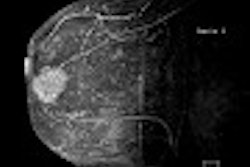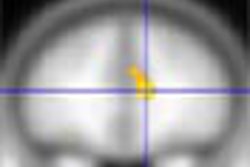MRI may become the modality of choice for neurologists who need an accurate and relatively rapid-fire way to select stroke candidates who are eligible for treatment with intravenous or intraarterial thrombolysis.
"Why do MRI for selection of candidates for standard IV altaplase treatment?" asked Dr. Steven Warach, Ph.D., during a presentation at the 2003 International Stroke Conference in Phoenix. "As we all know, the time pressures for assessing a patient for tPA (tissue plasminogen activator) are intense. As the time pressures increase, we can't do our usual, leisurely neurologic history and physical because the risk of misdiagnosis goes up. MRI gives us greater confidence in the diagnosis. And it could be -- and this is our hypothesis -- (that) a positive imaging diagnosis may improve the risk-benefit ratio for treatment."
Warach is chief of the National Institutes of Health Stroke Center at Suburban Hospital in Bethesda, MD. In many cases, he said, MR results could alter the treatment course for a patient who may not meet the clinical standards for tPA treatment.
"We will treat patients that would otherwise be excluded without the positive information of MRI," he said. "The patients with relative contraindications such as hypoglycemia, seizure at onset, or uncertain diagnosis are examples of patients who may come in a coma, or near coma. If the MRI shows an unambiguous signature of ischemic stroke on diffusion/perfusion MRA, these patients would get treatment."
Another benefit of MR is that it allows clinicians to determine the onset of the stroke. Warach said that if the index lesion appears older than three hours -- meaning that there is a clear shine-through on the FLAIR or T2-weighted MR images -- he goes back and talks to the patient or family in order to reexamine the estimated time of onset. "We usually find that the initial history of onset was incorrect. This is also a basic benefit of using MRI -- to help get the timing of onset right."Warach also emphasized MR’s role in screening stroke patients for multiple microbleeds, which can serve as a marker for tPA patients who are prone to hemorrhaging.
"Multiple microbleeds are being increasingly recognized as a concern," he said. Warach cited cases where patients with mild strokes, but several instances of microbleeds, were treated with antiplatelet therapies and then sent home. They returned to the hospital within 10 days of treatment with very serious -- and in one case fatal -- hemorrhages.
"The concern is that multiple microbleeds are a bleeding-prone risk for tPA. Taking all of the factors, that's a relative contraindication as we use this important information gathered from MRI examination," Warach explained.
Other contraindications for tPA therapy that can be seen on MR include the presence of other lesions indicating a heightened bleeding risk and acute or subacute lesions seen on diffusion-weighted images, which are asymptomatic and of indeterminate age. He noted that the appearance of such lesions could be "the imaging analogue of the clinical history of a recent stroke."
Currently underway at the NIH is a dose-escalation trial that compares a fixed dose of abciximab (ReoPro, Eli Lilly, Indianapolis) with an escalating dose of a combination of glycoprotein tPA inhibitor and thrombolytic, all under MR evaluation.
"We are trying to see if we can treat that disease up to 24 hours," Warach said. "These are mild to moderate strokes, so they are in lower-risk categories for hemorrhagic transformation. Our hypothesis is that reperfusion with this combination up to 24 hours would be safe in patients selected using MRI and that we can find an acceptable combination of drug therapy."
"The hypothesis here is that selecting the right patient, with the right characteristics and the right therapy, means that we can perhaps break the time barrier and make therapies available to all of the patients, not just the ones who come to the hospital within three hours (of stroke onset)," Warach concluded.
MRI and IA thrombolysis
In a second talk, Dr. Chelsea Kidwell focused on the role of MRI in IA thrombolysis. Kidwell is co-director of the UCLA Stroke Center, as well as an assistant professor of neurology at the University of California, Los Angeles.
"There are three potential applications of MRI for intra-arterial approaches. The first is to use MRI to identify salvageable ischemic tissue," Kidwell said. "The second is to try and identify tissue that is at increased risk of developing hemorrhagic transformation. And the third is to monitor the response to therapy, because this gives us some important insights into the ongoing pathophysiology of ischemia. The idea is to combine all of this information in order to optimize therapy and extend the time window."
Kidwell said multimodal MRI is particularly appealing as an acute stroke imaging modality because diffusion imaging "gives us a lot of information about the size, location, and severity of ischemic injury." MRI also produces information on perfusion status and vessel status.
Kidwell outlined some of the advantages of marrying MR technology to IA-based treatments.
One advantage is the potentially longer time window available for initiation of therapy.
"If we are using thrombolytics we can deliver a higher concentration of the lytic agent directly at the site of the clot," she said. "We also get precise knowledge of the anatomy and timing of recanalization. And this is very important because this now allows us to do precise correlations with some of the MRI outcome measures."
An ongoing study at UCLA uses pre- and posttreatment MRI with either combined IV/IA tPA, peer intra-arterial thrombolytics, or mechanical embolectomy. The patients are enrolled in the study if they have a large-vessel occlusion at angiography. MR is performed before therapeutics are administered, and again seven days later.
"So far, starting with our intra-arterial thrombolysis series, we've treated over 50 patients, achieving partial or complete recanalization in 68%. Our symptomatic hemorrhage rate is about 7%. And 47% of our patients are doing well neurologically with a modified Rankin score of 0-2," Kidwell reported.
The researchers also addressed the efficacy of the mismatch to identify or predict the ischemic penumbra. Kidwell described a patient who presented with a right ICA occlusion, left hemiparisis. According to the MR scan, there was a large perfusion deficit throughout the right hemisphere, and scattered perfusion abnormalities, with a large diffusion/perfusion mismatch. After treatment and vessel recanalization, the perfusion abnormality was resolved and actual therapeutic salvage of the mismatch region was achieved, she said.
Looking at the entire series of patients, Kidwell noted that the clinicians have been able to salvage about 80% of the region in patients with recanalization. "We found partial or complete reversal of diffusion abnormalities in 45 of our patients receiving inter-arterial thrombolysis, with a mean decrease in lesion size of 52%. Based on this data, we've suggested a modified view of the ischemic penumbra as defined by MRI, where the penumbra includes not only the diffusion/perfusion mismatch but also a portion of the initial diffusion abnormality itself."
In a second study with MR for pre-treatment evaluation, Kidwell said her group has found a penumbral pattern in 60% of patients. These patients then underwent recanalization, and 83% of them had a good to excellent neurologic outcome, she stated.
Kidwell emphasized that the analysis was preliminary and dealt with very small patient numbers. "But the data is intriguing," she said. "The mean Day 30-modified Rankin score for patients in each of the categories are shown, with the best group being recanalization with the penumbral pattern. MRI is essential in identifying these patients. MRI may be able to select the optimal patients for treatment by identifying both penumbral tissue and a high risk of developing hemorrhagic transformation."
Future studies will expand on these findings and validate MR as the first-line modality for treatment selection.
"We need to test this in clinical trials," Kidwell said. "This will allow us to potentially extend the time-window based on physiologic variables. We need to improve our methodology by incorporating additional techniques such as spectroscopy and oxygen-extraction fraction."
By Bruce SylvesterAuntMinnie.com contributing writer
March 25, 2003
Related Reading
Perfusion CT offers speedy access, but MRI gives the "big" picture, February 19, 2003
CT aids in tPA triage for stroke patients, February 17, 2003
Brain abnormalities on MRI seen after coronary bypass surgery, December 31, 2002
Diffusion-weighted MRI better than CT in stroke diagnosis, September 23, 2002
Copyright © 2003 AuntMinnie.com


















